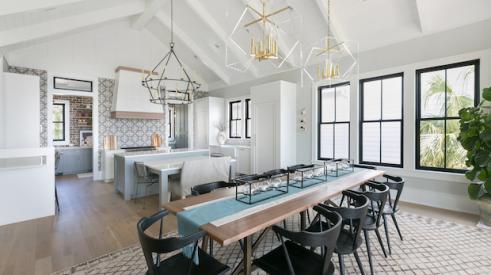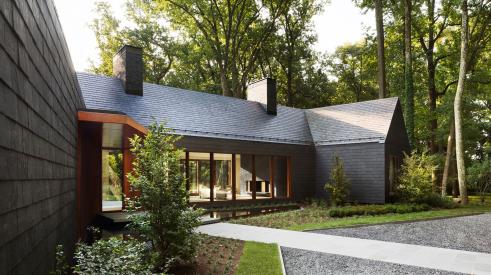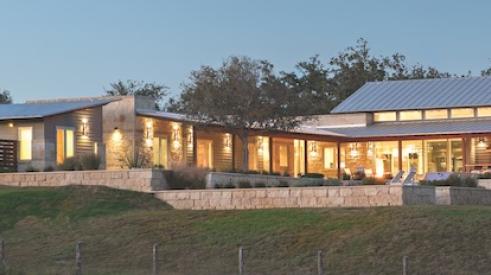|
Despite job losses and a weak economy, the outlook for rental housing is, for the most part, positive. CB Richard Ellis Econometric Advisors (CBRE-EA) forecasts that the vacancy rate for U.S. apartments will drop to an average of 6.8 percent in 2010, from an average of 7.4 percent in 2009. Rents, which have declined significantly, will begin to increase as discounts and concessions become less widespread, according to CBRE-EA.
| THE EXTERIOR OF OLYMPIC STUDIOS utilizes corrugated metal, plaster, exposed steel and metal panels, a good fit for Santa Monica’s light industrial district. Photo: Jim Simmons |
Market-research firm Green Street Advisors reports that public real-estate investment trusts (REITs) are gearing up to start nearly $1 billion in new multifamily projects this year. And projects that were started before the recession kicked in are coming online with sophisticated designs, upscale finishes and amenity packages that renters find hard to resist.
“Right now, rental is pretty much everything we're doing,” says Chad Askew of The Housing Studio, an architecture and planning firm based in Charlotte, N.C. “While the apartment market is stronger in some areas than others, it's certainly better than the for-sale market.”
Mark Humphreys, principal of Dallas-based Humphreys & Partners Architects, is confident that there will be growth in the rental sector. “All the studies show a large increase in demand starting in 2011 and going way up in 2012,” says Humphreys. He believes the incoming wave of echo boomers will create a paradigm shift similar to the garden-apartment boom of the 1970s.
Naturally, financing is an obstacle. While large REITs have the credit lines to fund new projects, for most builders FHA is virtually the only source of construction financing for multifamily rental properties. Lately FHA has been inundated with loan applications under the HUD Section 221(d)(4) and Section 223(f) programs. “We've done about 30 HUD deals, which gives us an advantage,” says Keith Anderson, executive vice president of Clark Builders Group in Arlington, Va. Clark expects to start several new projects this year.
In short, rental is a bright spot in the battered housing market. But renters demand a lot more than in years past, and to stay competitive, builders will need to step up their game. Here are four exemplary projects that have just the right mix of attributes to get renters in the door.
 |
|
HIGH WINDOWS ALLOW light and air into the loft units at Olympic Studios without compromising privacy. Photo: Jim Simmons |
Necessity is often the mother of invention. In the case of Olympic Studios, zoning requirements and the property owner's desire for as many units as possible led to the creation of a 375-square-foot, two-story “mini loft” product. Thanks to clever design that makes the units feel much larger; upscale finishes; attractive rents; and a prime location in Santa Monica, Calif., Olympic Studios has been 100 percent leased — all 165 units — since phase one opened in December 2008.
The project is located on an infill site in Santa Monica's Light Manufacturing Studio District, home to Universal Studios, Yahoo, Island Records and other music/film industry post-production facilities. The rents are affordable by local standards ($1,110 to $1,388 per month), with preference given to those who live and/or work in Santa Monica and earn annual incomes of $42,450 to $60,600, per municipal code. About 90 percent of the units are two-level lofts; the remainder are traditional flats.
“We knew that there was a strong market for units that were very well appointed but small in size,” says Jim Andersen, chief operating officer of NMS Properties, the project's Los Angeles-based developer. “We outfitted [Olympic Studios] with the same cabinetry, the same level of stainless steel appliances, the same granite countertops and the same fixtures we use in our luxury buildings. And we put it in a location that's within walking distance of employers, grocery stores, restaurants and shops.” In addition, Andersen says, a light-rail station is expected to open soon about half a block away.
Killefer Flammang Architects (KFA) of Santa Monica examined every conceivable way to make the units efficient without compromising livability. “A lot had to do with tucking things under stairs, like the shower, and sharing space,” says architect John Arnold. “The two-story design came from a quirk in the city's municipal code that allowed you to have extra building height, but not extra floors.” So KFA designed a unit with 20-foot ceilings and a mezzanine level, which doesn't count as a second floor because it's only 88 square feet. On the mezzanine level is a sleeping loft, with the living room, galley kitchen and bathroom below.
High windows bring plenty of light and air into the unit. “The sleeping loft is far removed from those upper windows, so there are no privacy issues,” Arnold says. He made the most of every square inch, interlocking the kitchens back to back. Shelves, drawers and nooks were built in throughout for storage and display.
Olympic Studios consists of two buildings with landscaped courtyards. Runoff is directed into an engineered, landscaped earth swale along the main street in front of the project. A two-level, underground parking garage serves both buildings and allowed the second building to be built slab on grade.
The contractor was Frymer Development, Santa Monica.
Part of the revitalization of a 16-acre stretch of oceanfront property in Long Branch, N.J., Pier Village Apartments attracts renters who aren't just looking for a summer home, but a year-round lifestyle.
The apartments are part of a larger mixed-use community that includes restaurants, retail stores and open spaces designed by Minno & Wasko Architects and Planners, Lambertville, N.J., and built by Applied Development Co., Hoboken, N.J. There are three phases (buildings) totaling 216 units. One-, two- and three-bedroom apartments range from 800 square feet to 1,200 square feet.
“Applied Development was able to do something important, which was to bring rental housing to the shore,” says architect Dave Minno, explaining that much of the development along the Jersey shore has been condominiums. “People tend to use [their condos] just for the summer, and essentially close them up for eight months of the year, which doesn't generate the year-round population that can be supportive of retail.”
Phase 1 of Pier Village Apartments, which was not designed by Minno & Wasko, “had a little bit more of a Victorian feel to it architecturally. We started to transition in Phase 2 to a more contemporary feel. The use of color remained strong, but we wanted to go a little more edgy and upbeat to attract a younger crowd that was primarily New York-oriented in their employment and general life emphasis. The third phase will be even more contemporary.”
As part of Phase 2, the architects designed a small boutique hotel called The Bungalow. “It's a very contemporary building with a sort of wing-shaped element at the top of the roof,” says Minno. “They show surfing movies at night on that wing-shaped piece of metal.”
Residents are a mix of empty nesters, young professionals, blue-collar workers from the Monmouth County area and students from Monmouth County Community College. Some commute to jobs in New York via the nearby light-rail station. “It's the last stop on the Jersey shore where you can get a one-seat ride into Manhattan,” Minno says, adding that the town of Long Branch plans to build a new pier with a ferry line that will give New York commuters another option.
In addition to the biggest amenity — the Atlantic Ocean — there is a multipurpose room, a swimming pool and a 350-space parking garage that is masked from the street to enhance the community's architectural ambience. Residents have access to the boardwalk and a crescent-shaped park that will support year-round activity such as ice skating and a farmer's market.
The ocean side of the development, Minno says, was easy to design because of the views. On the western side, a major north-south roadway, is a 50-foot, landscaped buffer. “That has actually become an amenity,” he says. “There are walking trails through it.”
Phase 2 leased up quickly, and the developer wants to move forward with Phase 3, he says. “The nightlife [at Pier Village] is very strong. There are great restaurants and a beach club that gets a young, hip crowd. It's become not only a place to live, but a destination.”
 |
|
PHASE 2 of Pier Village Apartments picks up the strong exterior colors of Phase 1, but has an edgier design to attract younger renters. Photo: New World Group |
Single-family feel
Fifteen years ago, Dallas-based Humphreys & Partners Architects developed The Big House®, a group of multifamily units disguised as a large single-family house. The Big House® has since been used in more than 250 projects, the latest iteration being Newport on the Lake, a 234-unit apartment community in Houston.
To be more precise, Newport on the Lake is in West Houston, near the suburb of Katy and in a Katy school district. The area is known as the Energy Corridor and attracts young professionals working at the oil and engineering companies headquartered on that side of town, says CEO Mark Humphreys. “If you've been relocated from Louisiana or California and have a $2,500 per month allowance for housing, you don't want to buy a house, and you don't want to live in a typical apartment project,” says Humphreys.
Newport is anything but typical. Many units have attached two-car garages. The two-bedroom apartments (designed for women, he says), have 11-foot-deep walk-in closets in the master bedroom. There are two dining areas, a dining room and a breakfast room, “which is unusual for an apartment, but not for a house.” Apartments range from 650 to 1,380 square feet.
Humphreys describes the architecture as coastal style, typified by siding and shingles. It's appropriate for this site, with its man-made lake. “We wanted to tie the architecture to that feeling of being on the water, and the indigenous landscape that you would see on a beach.” The groundcover of pine needles, and native plants such as pine trees, live oaks, palmettos and fountain grass, require little water. Turf was used only on the bocce ball court and the “sundowner deck,” which is actually a grassy area overlooking the lake. “People can sit out there on Adirondack chairs, have a glass of wine and enjoy the sunset,” says Humphreys.
Kayaks and bicycles are provided free to residents. There's also a clubhouse with a business center, fitness center, conference room and full kitchen, and a resort-style pool and spa with an outdoor kitchen.
Newport on the Lake was 95 percent leased at press time. It was developed by Cambridge Development Group, Houston, and built by C.F. Jordan, Dallas.
 |
|
Residents of Newport on the Lake can borrow kayaks to paddle around the community’s man-made lake. Photo: Richard L. Muniz Photography |
 |
|
Two-story townhouses at Camden College Park have stoops that connect to wide, tree-lined sidewalks. Flats are above the townhouses. The building facades are a mix of brick, fiber-cement trim and panels, and an exterior insulation finishing system (EIFS). Photo: Rick Alexander and Associates |
Camden College Park appeals to renters of all kinds, from students at the University of Maryland-College Park to young professionals and families with children. Even though the community is next door to an IKEA store and off Washington, D.C.'s busy Beltway, its pedestrian-friendly streets and multiple recreational spaces give it a genteel, suburban atmosphere.
Now 96 percent leased, Camden College Park was built on a 10-acre site that IKEA sold to Camden Property Trust, a REIT that develops apartments all over the U.S. Architect Chad Askew of The Housing Studio, an architecture firm based in Charlotte, N.C., sought to create a project “that had more of a contemporary feel but still some traditional design elements, in addition to a quality streetscape on the primary road that runs through the site.” Askew and his team designed townhouse-style units along this main street, with stoops that connect to the sidewalk. Flats are above the townhouses. Seven different courtyards are peppered throughout the community, including outdoor workout stations; lawns for golf, croquet and bocce; and a picnic area and playground.
Forty-seven different floor plans are offered among 508 units. Askew says this is partly because of the twists and turns the buildings take to fit the site. But there was also an effort to create a number of unique plans: “The basic interior layout might be the same, but with a number of iterations along the perimeter of the wall such as a bay in one location but not another, or a deep balcony in one spot and a very shallow or Juliet balcony in another.”
According to community manager Chris Williams, the diverse renter profile is due to the location, the standard features and most of all, the amenities, which (in addition to the courtyards) include a resort-style pool, a rock-climbing wall and a coffee bar with free Wi-Fi. There's also free parking, door-to-door trash pickup, optional storage-unit rentals, individual security alarms and an auto-care facility.
Keith Anderson, executive vice president of Clark Builders Group in Arlington, Va., says the project was completed in 21 months — “not bad from a production standpoint.” Because Clark shared an entrance with IKEA, arterial roads had to remain open during construction. “It was a tight site from an access point of view,” Anderson says. “But we got ahead of it early, thanks to the owner having a good action plan in place.”
|
Advertisement
Related Stories
Traditional Architecture With A Twist
Historic house shapes merged with modern features satisfy a variety of client wish lists while making neighbors happy
Dark Materials Tell the Story of This Home's Past
This house memorializes the owners’ previous abode, which had been destroyed by an electrical fire
Three Custom Homes Honored by Best in American Living Awards
These three custom homes stood out in the Best in American Living Awards for their site sensitivity and attention to detail







